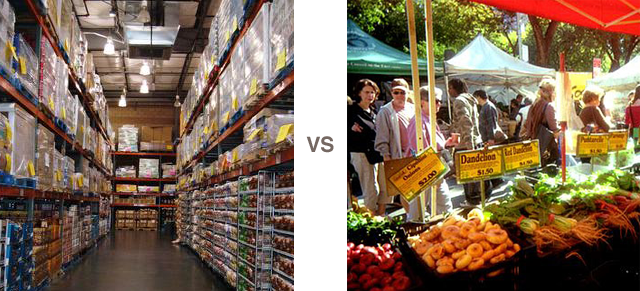Value : pain
I read an interesting article today: http://designmind.frogdesign.com/blog/mobile-apps-must-die.html
But I was less interested in the argument (which was that we need to stop flooding people with native apps because they’re annoying to install and organize), than in a simple principle they invoked:
One should always aim for a favorable value to pain ratio.
I was thinking about this today while wandering around in, of all places, Costco. Looking at the aisles and aisles of canned goods, prepackaged giant-sized meals and spaceship-like Krups coffee-pod systems, it hit me good and hard: it’s so hard to resist the industrial food system because the value to pain ratio is just so darn high.
Take a look at a one of those 1-gallon cans of corn. You can have, for the mere price of $4.79, something like 20 ears of corn, shucked, cut off the cob, sweetened, sterilized and preserved, ready to scoop out and use whenever you want it, in any precise quantity you want. Contrast this with 20 ears of farmer’s market corn: only available for 2 months in the Northeast, dirty, clunky, squeaky in their husks, and irredeemably festooned in a tangle of those darn corn whiskers. If you want to make corn salsa, or corn soup, or corn anything, you have to obtain, shuck, dewhisker, cut and cook it all yourself. And who knows how many ears = 1 U.S. measuring cup? All that just equals a pain in the butt, actually.
Of course, I’ll still argue in favor of the 20 ears of annoying farmer’s market corn. Better flavor, more nutrients, better for the local economy and the environment. We know all this by now, but we don’t act on it all the time. Why not? The value is great, but the pain is greater too. And in the end, the value to pain ratio tips in favor of pain.
I can think of only one way around this: to make those 20 ears of corn be more valuable. I mean, there’s not much I can do to mitigate the labors of eating fresh corn. But maybe, just maaaybe, there is a way to accord that corn with value beyond what it already has. What if fresh, just-picked local corn were associated with wonderful memories of eating roast corn-on-the-cob at a lakeside cottage with friends? And you would go out of your way just to remind yourself of those idyllic summer days? What if the long process of picking out and shucking that corn meant that you were spending more time with friends? What if it meant that you were making friends—with the farmers that worked so hard to grow them?
If you frame it the right way in your mind, the value shoots upward into infinity, and the pain seems negligible, really.
Value is kind of a funny thing—it can be created out of almost nothing. Nothing but thoughts, that is. Marketers know all about this when they try to sell you the same thing for $50 more just because a sexy lady is wearing it. And we know this too, but maybe we have been afraid to use this tactic because it seems so… well, crass.
But we don’t have to do it quite so crassly. We won’t use pictures… we’ll use real experiences. With real friends. We’ll create situations where food is appreciated, no matter how busy we are. We’ll find ways to sit down and spend an afternoon cutting corn off the cob, laughing at each other as the kernels get all over the floor. And we’ll rewrite the value proposition of real food. No sexy ladies needed.
(Unless your friends happen to be.)

>We’ll create situations where food is appreciated, no matter how busy we are.
Given that time is money — shallow, but an unfortunate reality for many people — wouldn’t the creation of such situations increase the cost of experiencing food idyllically, thereby increasing the pain once again? Will your thesis explore low-pain ways to create these experiences?
are you suggesting that I explore ways to create experiences that don’t take up any time?